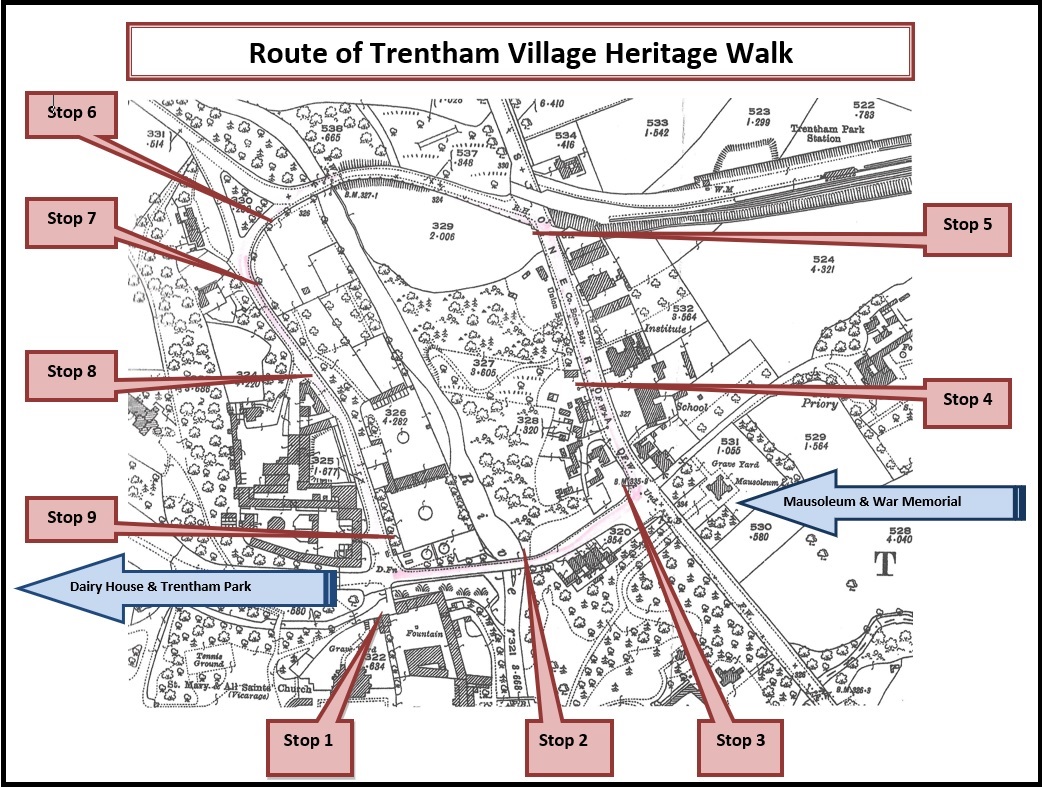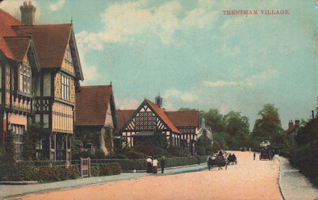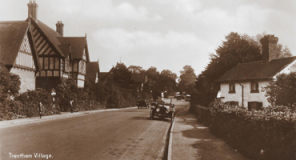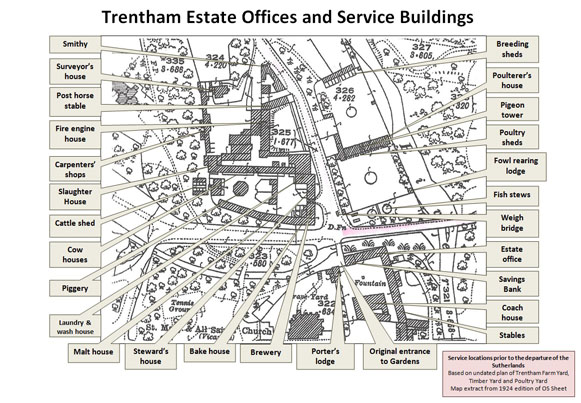



Estate yard
The entrance to the estate yard is over a bridge, originally a drawbridge over a moat. The tall building to the left was the estate office which included a savings bank with a vault. Inside were stables and coach houses. There was a lodge to the right, with windows allowing observance of all goods in and out of the yard. Behind was a drinking fountain with 3 cups and from here bread and beer were supplied to travellers.The family used the grand West Entrance to the house, the remains of which can still be seen in Trentham Park. This entrance, over the bridge was used by the public, who much enjoyed a day out at Trentham Gardens, including skating on the lake in winter. During WW1 the park was used for Army training in trench-making, bayonet exercise and bomb practice, also grazing for Army horses.
The Old Bridge
The old bridge in Park Drive was once part of a busy thoroughfare as the service road to Trentham Hall and beyond to Hanchurch and Eccleshall. In the 1740s Lord Gower wanted to discourage the public from using it as it passed too close to the hall so another bridge was built over the Trent to the north of here and Park Drive became virtually a private access road to the hall and church. It was later widened in the 1840s as part of Charles Barry's changes to the park. The River Trent flows down from the Potteries and on into Trentham gardens, which explains the pollution problem before adequate sewage systems were built.Poultry house garden
 We have a good view of the rear of the Poultry House, which we shall see again at the end of our walk.
It had extensive gardens and there were fish stews (ponds) where the church car park is now, fed from Park Brook.
Note the small lodge near the river which seems to have been used for rearing fowl and the tower which housed pigeons.
We have a good view of the rear of the Poultry House, which we shall see again at the end of our walk.
It had extensive gardens and there were fish stews (ponds) where the church car park is now, fed from Park Brook.
Note the small lodge near the river which seems to have been used for rearing fowl and the tower which housed pigeons.
Park Cottages
 These derelict remains are all that is left of four ornamental brick and tile cottages built in 1842.
One of the cottages was used as a girls’ and infants’ school in the 1860s.
The cottages were abandoned about 1980.
These derelict remains are all that is left of four ornamental brick and tile cottages built in 1842.
One of the cottages was used as a girls’ and infants’ school in the 1860s.
The cottages were abandoned about 1980.
Trentham Gardens entrance
 Originally this was a private road used by the Sutherlands to take their deceased
to the mausoleum opposite. It later became the public entrance to the gardens.
The lodges and gates were moved here from the West entrance in the 1930s.
Originally this was a private road used by the Sutherlands to take their deceased
to the mausoleum opposite. It later became the public entrance to the gardens.
The lodges and gates were moved here from the West entrance in the 1930s.

Mausoleum
Over the road is the Sutherland Mausoleum which was built in 1808, and is the only Grade 1 listed building in Stoke-on-Trent.
War Memorial
Trentham WW1 project began with the War Memorial. In 2014 we decided to research the names of the 17 men inscribed on the memorial which led us on to find out more about their lives. The Memorial cross was unveiled 2 October 1921. The inscription reads: In grateful memory of the men of Trentham who fell in the Great War and lists 16 names, plus one who died at a later date. The dedication is an unusual one which reads: This memorial cross is the gift of the women of Trentham.Entrance to the Priory
 The footpath
to the left of the mausoleum is the former driveway to The Priory. The Priory,
a former vicarage, was built in the late 18th century. In 1911 it was occupied
by the Wenger family, who manufactured colours and glazes for the pottery
industry. It was demolished in the late 50s and its site developed into Wenger
Crescent.
The footpath
to the left of the mausoleum is the former driveway to The Priory. The Priory,
a former vicarage, was built in the late 18th century. In 1911 it was occupied
by the Wenger family, who manufactured colours and glazes for the pottery
industry. It was demolished in the late 50s and its site developed into Wenger
Crescent. 
Schoolmaster’s House
The schoolmaster’s house was the other side of the Priory entrance. It was home to Claude Ramon Forse, one of the 17 names on the War Memorial, who was killed in military action in 1918. His wife, Margaret, who was also a teacher, died in 1973, aged 93. The school itself was next door. Sadly, all the buildings on that side of the road were demolished in the 1960s, but they were much photographed so we know what this part of the village looked like in 1916.Poachers' Cottage
 In 1911 this was the home of huntsman, William Boxall. He began riding as
a youngster at Newmarket. In 1873 he came second at the Liverpool Grand National,
and on the same horse he won the Sefton cup steeplechase the next day. He
was riding for Mr Henry Chaplin, who was married to Florence, daughter of
the Duke of Sutherland.
In 1911 this was the home of huntsman, William Boxall. He began riding as
a youngster at Newmarket. In 1873 he came second at the Liverpool Grand National,
and on the same horse he won the Sefton cup steeplechase the next day. He
was riding for Mr Henry Chaplin, who was married to Florence, daughter of
the Duke of Sutherland. Pear Tree Cottage
Rose Cottage
These are two old cottages behind the Harvester. Pear Tree cottage was the home of Frederick Johnson, a blacksmith who worked on the estate.Yew Tree Cottage
Yew Tree cottage was the home of William and Sarah Jones. Both served the Sutherland family: William for over 50 years, under 3 Dukes. They had occupied Yew Tree cottage since their marriage on 2nd June 1852. Their diamond wedding celebration in 1912 was reported in the Sentinel. Their son Robert Jones, who had previously served in the Hussars, enlisted in the Army Service Corps at Leicester on 12th June 1915, age 44.Cranberry Cottage
Cranberry Cottage was designed in 1850 by Charles Barry with its basement intended for a post office. By 1911 it was occupied by the sub postmaster, James Calvert, assisted by his wife Sarah. James Calvert was a cousin of Frank Harris, and those of you that have seen the film “Letters to Hem Heath” will remember Frank the postman. Their son Kendal Calvert joined the Royal Navy in 1908 and served on a variety of ships until 1924 when he was invalided out. After WW1 the Post Office moved to a house on Longton Road.
Trentham School
A boys' school was first opened in Trentham in 1674. A girls' school was established by the Duchess of Sutherland by 1840. The building shown in the photo, built by order of the Duke, was opened in 1877. In 1916 there were 236 pupils, boys and girls and Headmaster, Mr Forse, reported in 1912 that three new subjects had been added to the curriculum: bee-keeping, poultry-keeping and woodwork, practical subjects which were used as a foundation for other school work. In the 1960s the school was no longer adequate for the increased population. It was closed in 1962 and demolished in 1965.The Institute
 The
4th Duke of Sutherland gifted the Institute, opened in 1894, which was aimed
at the educational improvement of villagers. It had a billiard room, a stocked
library, a reading room and classrooms, a kitchen, a workshop for handicrafts
and a refreshment bar. By 1921 the refreshment room had become something of
a liability: droves of Potteries holiday makers used the Institute as a catering
establishment when they visited the Park. It was reported that “The unruly
mob do a certain amount of mischief and leave behind them a terrible mess!"
In the 1911 census Henry Swift Penson is listed as the steward. Henry and
his brother Frederick were both professional artists. Henry exhibited at the
Royal Academy and taught at the Stoke School of Art and worked as a designer
for Minton Hollins ltd. Paintings by Frederick Penson, including landscapes
of Trentham were gifted by the family to Hanley Museum and Art Gallery. Henry
Swift Penson had two sons, Charles and Edward. Edward Penson enlisted in 1915
but was never sent abroad and was discharged in 1917 as medically unfit.
The
4th Duke of Sutherland gifted the Institute, opened in 1894, which was aimed
at the educational improvement of villagers. It had a billiard room, a stocked
library, a reading room and classrooms, a kitchen, a workshop for handicrafts
and a refreshment bar. By 1921 the refreshment room had become something of
a liability: droves of Potteries holiday makers used the Institute as a catering
establishment when they visited the Park. It was reported that “The unruly
mob do a certain amount of mischief and leave behind them a terrible mess!"
In the 1911 census Henry Swift Penson is listed as the steward. Henry and
his brother Frederick were both professional artists. Henry exhibited at the
Royal Academy and taught at the Stoke School of Art and worked as a designer
for Minton Hollins ltd. Paintings by Frederick Penson, including landscapes
of Trentham were gifted by the family to Hanley Museum and Art Gallery. Henry
Swift Penson had two sons, Charles and Edward. Edward Penson enlisted in 1915
but was never sent abroad and was discharged in 1917 as medically unfit. Hunt Stables
 The
next building housed the North Staffordshire hunt stables, on the site of
the old Trentham Inn. Since 1862 the hunt stables had been managed at Trentham,
its employees being maintained at the Sutherland’s expense. Up to 60 hunters
were stabled at Trentham and a pack of 50-60 hounds were kennelled nearby,
which we shall learn more of later. The hunt met four days a week before the
war. During war time the hunt continued to meet twice a week. William Henry
Jones (one of the 17 names) worked as a huntsman at Trentham for 4 years before
the war, enlisting in 1915 at Stoke. He served in France in the Machine Gun
Corps and was killed in action on 3 September 1916 during the Somme campaign.
The
next building housed the North Staffordshire hunt stables, on the site of
the old Trentham Inn. Since 1862 the hunt stables had been managed at Trentham,
its employees being maintained at the Sutherland’s expense. Up to 60 hunters
were stabled at Trentham and a pack of 50-60 hounds were kennelled nearby,
which we shall learn more of later. The hunt met four days a week before the
war. During war time the hunt continued to meet twice a week. William Henry
Jones (one of the 17 names) worked as a huntsman at Trentham for 4 years before
the war, enlisting in 1915 at Stoke. He served in France in the Machine Gun
Corps and was killed in action on 3 September 1916 during the Somme campaign.
Crown Cottage
 Looking now at the land on this side of the road, there used to be another cottage opposite the hunt stables, called Crown Cottage.
In appearance it was similar to Cranberry cottage.
Here lived the Furnival family: Tom Furnival was 2nd huntsman to Cromartie, the 4th Duke of Sutherland – His Grace being No 1.
Tom was an authority on horses and during WW1, with his son Arthur, he broke in animals for the Army Remount Depot . The horses were brought from Canada and collected from Longport Station. The Remount service across the UK provided 1.5million horses during the course of the Great War.
Looking now at the land on this side of the road, there used to be another cottage opposite the hunt stables, called Crown Cottage.
In appearance it was similar to Cranberry cottage.
Here lived the Furnival family: Tom Furnival was 2nd huntsman to Cromartie, the 4th Duke of Sutherland – His Grace being No 1.
Tom was an authority on horses and during WW1, with his son Arthur, he broke in animals for the Army Remount Depot . The horses were brought from Canada and collected from Longport Station. The Remount service across the UK provided 1.5million horses during the course of the Great War.
Station Master’s house
Ticket Master’s cottage
Trentham Park Station and Branch Line
 The two black and white houses opposite here are the Station house and Ticket master’s cottage, reminders of Trentham Park Station.
Alongside you can see the drive which led up to the station itself.
The North Staffordshire Railway Company opened its Trentham Park branch line in 1910.
It branched off the main line at Trentham Station, was carried over a bridge at New Inn Lane and across to Trentham Park.
The line became very popular with visitors to the gardens.
The two black and white houses opposite here are the Station house and Ticket master’s cottage, reminders of Trentham Park Station.
Alongside you can see the drive which led up to the station itself.
The North Staffordshire Railway Company opened its Trentham Park branch line in 1910.
It branched off the main line at Trentham Station, was carried over a bridge at New Inn Lane and across to Trentham Park.
The line became very popular with visitors to the gardens.
The Bridge to Nowhere
 There were plans to extend the line round Newcastle-under-Lyme and on to Silverdale and a bridge was built over the A34 in September 1914.
But these plans were delayed by the Great War and the scheme was abandoned in the 1920s.The bridge was dismantled and sold for scrap in WW2
although as it was cast iron it could not be used and was dumped out at sea.
There were plans to extend the line round Newcastle-under-Lyme and on to Silverdale and a bridge was built over the A34 in September 1914.
But these plans were delayed by the Great War and the scheme was abandoned in the 1920s.The bridge was dismantled and sold for scrap in WW2
although as it was cast iron it could not be used and was dumped out at sea.
Whitmore Road
 This bridge and road were built in the 1740s in an attempt to move the public away from the park.
It didn't work as there was still a right of way through the park!
The road was improved and extended to Whitmore station once the railway arrived in the 1840s.
This bridge and road were built in the 1740s in an attempt to move the public away from the park.
It didn't work as there was still a right of way through the park!
The road was improved and extended to Whitmore station once the railway arrived in the 1840s.
Dog Kennels
The kennels were built in the 1840s by the Marquis of Stafford, the eldest son of the second Duke of Sutherland. In 1862 the North Staffordshire hunting hounds moved to Trentham and the kennels were enlarged to include lodgings. Fox hounds were accommodated on the ground floor, with sleeping accommodation for some of the hunt servants on the first floor. The entrance was where Fairway is now. All the buildings have been demolished except one cottage on the right of the road. The census of 1911 lists four households on the site, including that of William Wheatley, huntsman. Born in Ireland, he took over Trentham kennels in 1903 and continued until his retirement in 1925.Dairyfields
The Dairyfields area, on the other side of the road from the kennels, was offered for sale in May 1929 as the finest building site in the district.School house
Teacher’s house
 The
Duchess’s girls’ school was opened in a pair of converted cottages around
1840. The school occupied one cottage while the schoolmistress lived in the
other. In 1863 the school was moved to one of the Park Drive cottages near
the old bridge over the Trent. The NS Hunt took over the original girls’ school.
After the hunt moved to Hill Chorlton in 1930 the cottages became private
residences.
The
Duchess’s girls’ school was opened in a pair of converted cottages around
1840. The school occupied one cottage while the schoolmistress lived in the
other. In 1863 the school was moved to one of the Park Drive cottages near
the old bridge over the Trent. The NS Hunt took over the original girls’ school.
After the hunt moved to Hill Chorlton in 1930 the cottages became private
residences. Gas house
 Next door is the derelict Gas House. Climbing the bank is possible but care should be taken.
When Trentham Hall was rebuilt in the 1830s and 1840s gas lighting was installed.
The British Gas Company works at Etruria were too far away to serve Trentham Hall,
so a private gas works was designed and built in a quarry, which provided a ready-made enclosure for the gasometer.
Electricity came from The Turbine farm (now Hissey’s garage).
Next door is the derelict Gas House. Climbing the bank is possible but care should be taken.
When Trentham Hall was rebuilt in the 1830s and 1840s gas lighting was installed.
The British Gas Company works at Etruria were too far away to serve Trentham Hall,
so a private gas works was designed and built in a quarry, which provided a ready-made enclosure for the gasometer.
Electricity came from The Turbine farm (now Hissey’s garage).
Ice house

 The entrance to the ice house is over the bank and to the left of the gas house.
The ice house was built into the side of the old quarry in 1843 and described as an ice well on drawing plans.
Its purpose was to store meat from the nearby slaughterhouse with ice collected from the lake, insulated with straw.
The entrance to the ice house is over the bank and to the left of the gas house.
The ice house was built into the side of the old quarry in 1843 and described as an ice well on drawing plans.
Its purpose was to store meat from the nearby slaughterhouse with ice collected from the lake, insulated with straw.
The Smithy
 ©Lovatt Collection, Stoke on Trent City Archives
©Lovatt Collection, Stoke on Trent City Archives Fire engine house
 The fire engine house and cart shed were on the yard alongside the blacksmith’s
shop. The duke had two horse drawn steam fire engines and his own fire brigade
at the hall, where fire was an ever present danger. During WW1 there was also
a very real threat from Zeppelin raids. On the night of 31 January 1916 seven
bombs were dropped from Zeppelins on Sideway colliery 'without much damage'.
They were heading for Crewe and returned via the Black Country where they
did a considerable amount of damage. On 27th November 1916 bombs were dropped
on collieries between Fenton and Trentham and an unexploded dud was found
at Blurton Waste Farm. Fortunately, no damage or injury was caused but it
must have been a terrifying experience.
The fire engine house and cart shed were on the yard alongside the blacksmith’s
shop. The duke had two horse drawn steam fire engines and his own fire brigade
at the hall, where fire was an ever present danger. During WW1 there was also
a very real threat from Zeppelin raids. On the night of 31 January 1916 seven
bombs were dropped from Zeppelins on Sideway colliery 'without much damage'.
They were heading for Crewe and returned via the Black Country where they
did a considerable amount of damage. On 27th November 1916 bombs were dropped
on collieries between Fenton and Trentham and an unexploded dud was found
at Blurton Waste Farm. Fortunately, no damage or injury was caused but it
must have been a terrifying experience. Surveyor’s house
Overlooking the yard was the surveyor’s house, home for many years to Thomas Roberts who was the estate architect from 1841 until his retirement aged 81. It is now a private residence.Peacock House
The Poulterer’s house and adjacent buildings were erected in the 1840s and have survived relatively unchanged. The elaborate gardens on the south side, together with the fish stews, now form the church car park. Gardens on the north side have been developed for private housing and at one time this was a Police house for the Stone District. The part of the house nearest the road was where the poulterer lived and after the war, when redundant as a poulterer's house, this housed the local police officer for Stone District.Laundry
The first section of the courtyard development is the former laundry. In 1914 the laundry was no longer needed and the estate looked at either letting it, or converting it to 3 cottages. The old laundry is now private homes. The adjacent drying area, which had washing lines made of stranded copper wire, has also been built over.Courtyard :
Estate steward
Brewery
Malthouse
Cowsheds
Slaughter house
 As you can see, the buildings in the courtyard have been converted to residential accommodation.
The residents do have problems with visitors peering through windows etc and have asked that we are mindful of their privacy.
As you can see, the buildings in the courtyard have been converted to residential accommodation.
The residents do have problems with visitors peering through windows etc and have asked that we are mindful of their privacy.
 The courtyard comprises estate buildings designed by Charles Barry, with the
appearance of a rural Italian courtyard. The front range was the home of the
estate steward on one side, with the brewery and malt house on the other.
The North and East sides of the yard were occupied by cowsheds, while the
buildings in the centre were occupied by pigs. The central block contained
the bailiff’s office. The slaughter house was at the rear of the courtyard.
Herbert Challinor worked here – he was butcher to the Duke of Sutherland.
His son, William Challinor, was killed on active service in France on 3rd
September 1918 and is one of the 17 names on the War Memorial.
The courtyard comprises estate buildings designed by Charles Barry, with the
appearance of a rural Italian courtyard. The front range was the home of the
estate steward on one side, with the brewery and malt house on the other.
The North and East sides of the yard were occupied by cowsheds, while the
buildings in the centre were occupied by pigs. The central block contained
the bailiff’s office. The slaughter house was at the rear of the courtyard.
Herbert Challinor worked here – he was butcher to the Duke of Sutherland.
His son, William Challinor, was killed on active service in France on 3rd
September 1918 and is one of the 17 names on the War Memorial.